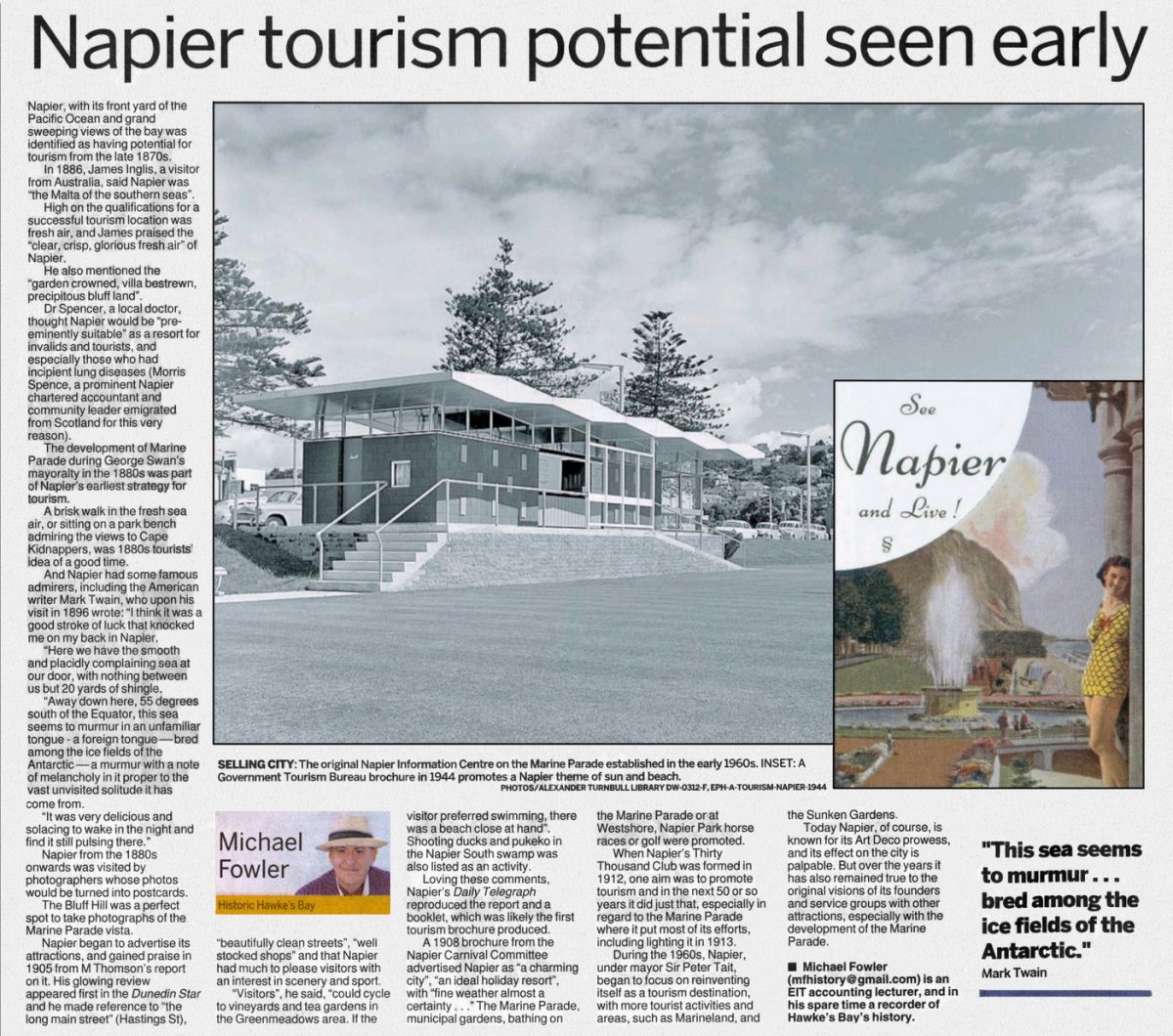Napier tourism potential seen early
Napier, with its front yard of the Pacific Ocean and grand sweeping views of the bay was identified as having potential for tourism from the late 1870s.
In 1886, James Inglis, a visitor from Australia, said Napier was “the Malta of the southern seas”.
High on the qualifications for a successful tourism location was fresh air, and James praised the “clear, crisp, glorious fresh air” of Napier.
He also mentioned the “garden crowned, villa bestrewn, precipitous bluff land”.
Dr Spencer, a local doctor, thought Napier would be “pre-eminently suitable” as a resort for invalids and tourists, and especially those who had incipient lung diseases (Morris Spence, a prominent Napier chartered accountant and community leader immigrated from Scotland for this very reason).
The development of Marine Parade during George Swan’s mayoralty in the 1880s was part of Napier’s earliest strategy for tourism.
A brisk walk in the fresh sea air, or sitting on a park bench admiring the views to Cape Kidnappers, was 1880s tourists’ idea of a good time.
And Napier had some famous admirers, including the American writer Mark Twain, who upon his visit in 1896 wrote: “I think it was a good stroke of luck that knocked me on my back in Napier.
“Here we have the smooth and placidly complaining sea at our door, with nothing between us but 20 yards of shingle.
“Away down here, 55 degrees south of the Equator, this sea seems to murmur in an unfamiliar tongue – a foreign tongue – bred among the ice fields of the Antarctic – a murmur with a note of melancholy in it proper to the vast unvisited solitude it has come from.
“It was very delicious and solacing to wake in the night and find it still pulsing there.”
Napier from the 1880s onwards was visited by photographers whose photos would be turned into postcards.
The Bluff Hill was a perfect spot to take photographs of the Marine Parade vista.
Napier began to advertise its own attractions, and gained some praise in 1905 from M Thomson’s report on it. His glowing review appeared first in the Dunedin Star and he made reference to “the long main street” (Hastings St), “beautifully clean streets”, “well stocked shops” and that Napier had much to please visitors with an interest in scenery and sport.
“Visitors”, he said, “could cycle to vineyards and tea gardens in the Greenmeadows area. If the visitor preferred swimming, there was a beach close at hand.” Shooting ducks and pukeko in the Napier South swamp was also listed as an activity.
Loving these comments, Napier’s Daily Telegraph reproduced the report and a booklet, which was likely the first tourism brochure produced.
A 1908 brochure from the Napier Carnival Committee advertised Napier as “a charming city”, “an ideal holiday resort” with “fine weather almost a certainty…” The Marine Parade, municipal gardens, bathing on the Marine Parade or at Westshore, Napier Park horse races or golf were promoted.
When Napier’s Thirty Thousand Club was formed in 1912, one aim was to promote tourism and in the next 50 or so years it did just that, especially in regard to the Marine Parade where it put most of its efforts, including lighting it in 1913.
During the 1960s, Napier, under mayor Sir Peter Tait, began to focus on reinventing itself as a tourism destination, with more tourist activities and areas, such as Marineland, and the Sunken Gardens,
Today Napier, of course, is known for its Art Deco prowess, and its effect on the city is palpable. But over the years has also remained true to the original visions of its founders and service groups with other attractions, especially with the development of the Marine Parade.
“This sea seems to murmur…bred among the ice fields of Antarctic.”
Mark Twain
Michael Fowler ([email protected]) is an EIT accounting lecturer, and in his spare time a recorder of Hawke’s Bay’s history.
Photo caption –
SELLING CITY: The original Napier information Centre on the Marine Parade established in the early 1960s. INSET: A Government Tourism Bureau brochure in 1944 promotes a Napier theme of sun and beach.
PHOTOS/ALEXANDER TURNBULL LIBRARY DW-0312-F, EPH-A-TOURISM NAPIER-1944












Do you know something about this record?
Please note we cannot verify the accuracy of any information posted by the community.